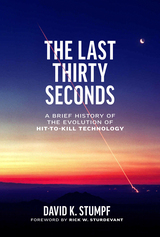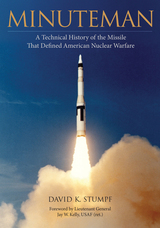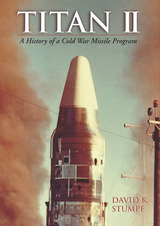3 books about Stumpf, David K.

The Last Thirty Seconds
A Brief History of the Evolution of Hit-to-Kill Technology
David K. Stumpf
University of Arkansas Press, 2024
In March 1983, as the world’s superpowers continued aggressively stockpiling nuclear weapons, President Ronald Reagan described his vision for a world no longer confronted with the concept of mutually assured destruction. A year later the Strategic Defense Initiative was established, followed soon after by the creation of the Strategic Defense Initiative Organization (SDIO). The SDIO was tasked with the development and coordination of missile technologies designed for the strategic defense against civilization’s most dangerous invention, one that carried with it the threat of nuclear destruction—intercontinental ballistic missiles.
In The Last Thirty Seconds: A Brief History of the Evolution of Hit-to-Kill Technology, David K. Stumpf details the development of one of many possible solutions for ballistic missile defense commonly known as hit-to-kill. Hit-to-kill is a nonnuclear technique using kinetic energy, rather than explosives, to destroy reentry vehicles carrying chemical, biological, or nuclear warheads. It is the centerpiece of the United States’ current ballistic missile defense systems and has proven invaluable in the conflict between Ukraine and Russia as well as in the ongoing conflict with the Houthi rebels in the Red Sea. While much of the subject remains classified, this detailed study will be welcomed for its substantial references and the inclusion of newly declassified material.
In The Last Thirty Seconds: A Brief History of the Evolution of Hit-to-Kill Technology, David K. Stumpf details the development of one of many possible solutions for ballistic missile defense commonly known as hit-to-kill. Hit-to-kill is a nonnuclear technique using kinetic energy, rather than explosives, to destroy reentry vehicles carrying chemical, biological, or nuclear warheads. It is the centerpiece of the United States’ current ballistic missile defense systems and has proven invaluable in the conflict between Ukraine and Russia as well as in the ongoing conflict with the Houthi rebels in the Red Sea. While much of the subject remains classified, this detailed study will be welcomed for its substantial references and the inclusion of newly declassified material.
[more]

Minuteman
A Technical History of the Missile That Defined American Nuclear Warfare
David K. Stumpf
University of Arkansas Press, 2020
In Minuteman: A Technical History of the Missile That Defined American Nuclear Warfare, David K. Stumpf demystifies the intercontinental ballistic missile program that was conceived at the end of the Eisenhower administration as a key component of the US nuclear strategy of massive retaliation. Although its nuclear warhead may have lacked power relative to that of the Titan II, the Minuteman more than made up for this in terms of numbers and readiness to launch—making it the ultimate ICBM.
Minuteman offers a fascinating look at the technological breakthroughs necessary to field this weapon system that has served as a powerful component of the strategic nuclear triad for more than half a century. With exacting detail, Stumpf examines the construction of launch and launch control facilities; innovations in solid propellant, lightweight inertial guidance systems, and lightweight reentry vehicle development; and key flight tests and operational flight programs—all while situating the Minuteman program in the context of world events. In doing so, the author reveals how the historic missile has adapted to changing defense strategies—from counterforce to mutually assured destruction to sufficiency.
Minuteman offers a fascinating look at the technological breakthroughs necessary to field this weapon system that has served as a powerful component of the strategic nuclear triad for more than half a century. With exacting detail, Stumpf examines the construction of launch and launch control facilities; innovations in solid propellant, lightweight inertial guidance systems, and lightweight reentry vehicle development; and key flight tests and operational flight programs—all while situating the Minuteman program in the context of world events. In doing so, the author reveals how the historic missile has adapted to changing defense strategies—from counterforce to mutually assured destruction to sufficiency.
[more]

Titan II
A History of a Cold War Missile Program
David K. Stumpf
University of Arkansas Press, 2001
The Titan II ICBM (intercontinental ballistic missile) program was developed by the United States military to bolster the size, strength, and speed of the nation’s strategic weapons arsenal in the 1950s and 1960s. Each missile carried a single warhead—the largest in U.S. inventory—used liquid fuel propellants, and was stored and launched from hardened underground silos. The missiles were deployed at basing facilities in Arkansas, Arizona, and Kansas and remained in active service for over twenty years. Since military deactivation in the early 1980s, the Titan II has served as a reliable satellite launch vehicle.
This is the richly detailed story of the Titan II missile and the men and women who developed and operated the system. David K. Stumpf uses a wide range of sources, drawing upon interviews with and memoirs by engineers and airmen as well as recently declassified government documents and other public materials. Over 170 drawings and photographs, most of which have never been published, enhance the narrative. The three major accidents of the program are described in detail for the first time using authoritative sources.
Titan II will be welcomed by librarians for its prodigious reference detail, by technology history professionals and laymen, and by the many civilian and Air Force personnel who were involved in the program—a deterrent weapons system that proved to be successful in defending America from nuclear attack.
This is the richly detailed story of the Titan II missile and the men and women who developed and operated the system. David K. Stumpf uses a wide range of sources, drawing upon interviews with and memoirs by engineers and airmen as well as recently declassified government documents and other public materials. Over 170 drawings and photographs, most of which have never been published, enhance the narrative. The three major accidents of the program are described in detail for the first time using authoritative sources.
Titan II will be welcomed by librarians for its prodigious reference detail, by technology history professionals and laymen, and by the many civilian and Air Force personnel who were involved in the program—a deterrent weapons system that proved to be successful in defending America from nuclear attack.
[more]
READERS
Browse our collection.
PUBLISHERS
See BiblioVault's publisher services.
STUDENT SERVICES
Files for college accessibility offices.
UChicago Accessibility Resources
home | accessibility | search | about | contact us
BiblioVault ® 2001 - 2024
The University of Chicago Press









